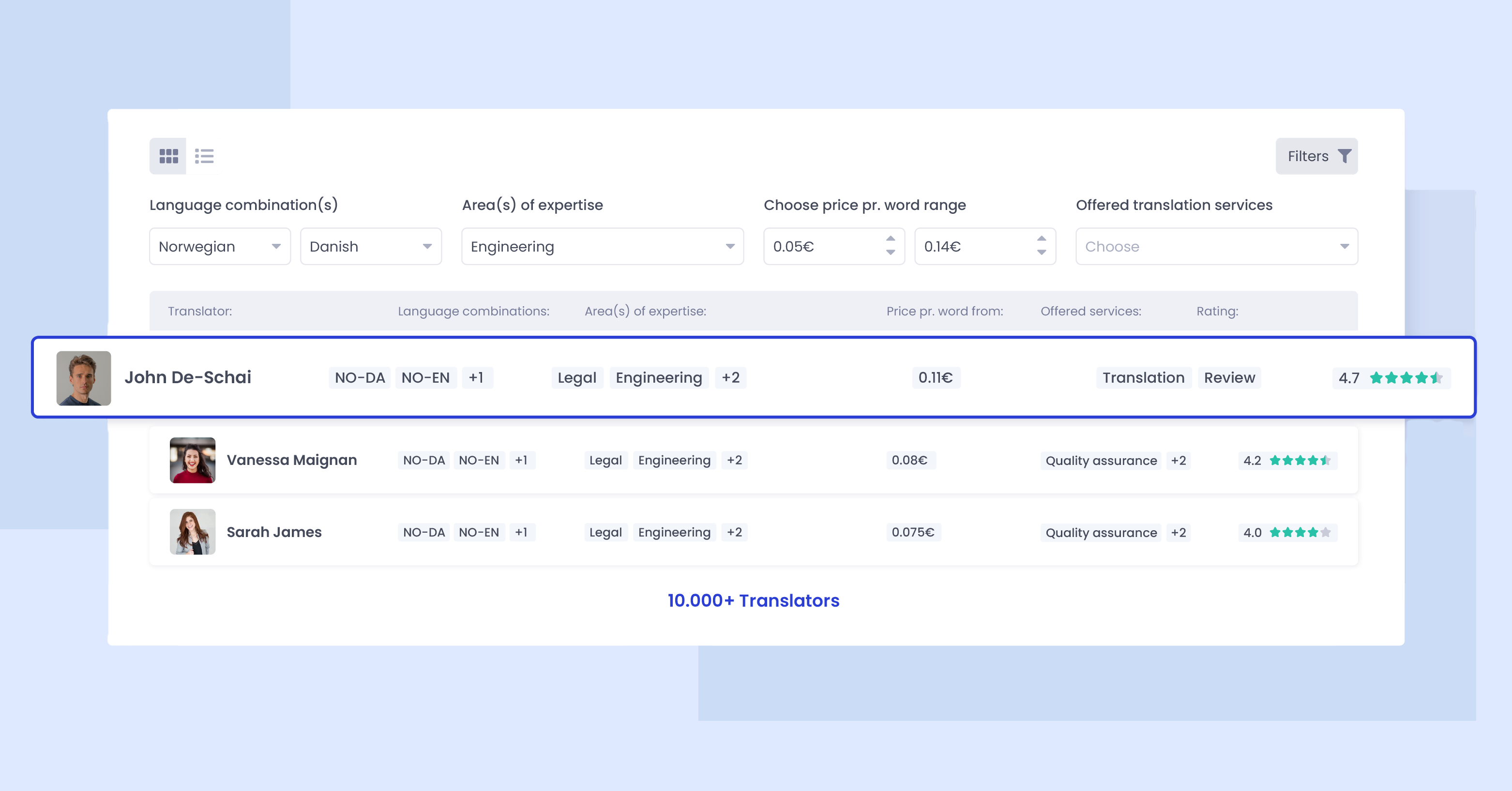7 Tips for a Fruitful Collaboration With Translators
Jul 29, 2022 11:49:55 AM | 5 min | Localisation strategy
7 Tips for a Fruitful Collaboration With Translators
If you are not considering collaboration with translators as part of your translation strategy, you are missing out on the chance of producing the best possible translations and streamlining your daily flow of projects. You risk ending up with generic, bland content that is not specific to your brand. On the other hand, a great collaboration gives you the chance to really distinguish yourself from your competitors.
The major key here is communication. It is the overarching theme and most important factor when it comes to a fruitful collaboration between businesses and linguists. However, what that involves is not as obvious as it seems and certain aspects tend to be overlooked.
I interviewed several professional translators and found out what they really want you to know when it comes to a constructive collaboration. In addition, I spoke to different localisation managers to gather some insights on what has or hasn’t worked for them from a business perspective.
Whether it is your first time collaborating with translators or you just want to enhance the collaborative efforts of your localisation strategy, the following tips will empower you to achieve a fruitful collaboration with your translators.
1. Be proactive
Sometimes translations are required as quickly as possible, for example when new products need to be launched on a tight deadline. This can lead to skipping communication in the early stages of the onboarding of new translators, due to the worry that good collaboration with translators would mean a huge time commitment. However, spending time on the onboarding of your translators to ensure that they are ready for the task and staying available to clarify any questions is crucial. If you are clear in your instructions at the beginning, you won’t have to fix the problems later on which will cost you much more time.
Some localisation managers suggest having a short video call for a brief introduction “in person” when enrolling new translators. Some may even let translators try out their product or service. Physically engaging with the products helps linguists to get a deeper understanding of your brand. Training your team as you would do with an internal copywriter will always give you the best results.
The early stages of collaboration can also be a good opportunity to try out different translation methods together. You can reference our blogpost about diversifying your translation methods to cut costs and find out how to choose the right method for different types of content.
The bottom line is to be proactive and make the time commitment of communicating with your translators early on. This small time investment upfront will be worth it for the future of your collaboration.
2. Provide context
It might seem obvious, but don’t forget to provide basic context information during the onboarding of your team of translators. It is crucial to let your linguist know about your type of company and industry. Even your company name can be a valuable reference point. Furthermore, they should be aware of the purpose of the text they are supposed to produce. A marketing text is written completely differently from a product description, a manual or an internal informational document.
Most importantly, it is of great importance to let your freelancers in on your target audience. Your content will be more persuasive and attractive to the group of people you are trying to reach.
To sum it up, great content and accurate localisation are achievable through active dialogue rather than guesswork. Without context information, translators have to make assumptions based on minimal clues in the text and the localisation of your content becomes a guessing game.
3. Give clear style instructions to stay on brand
There are several pieces of information that are crucial to creating on-brand content. This includes your organisation’s communication style and tone of voice. Translator instruction should also include any special terminology and non-translatables. It is a good idea for you or your translator to create a glossary of terms over time that includes the vocabulary you would like to use.
You might be surprised to hear that the most difficult translations are not philosophical treatises or literary masterpieces, they are the single-word entries in a spreadsheet from a textile manufacturer or a bank, for example. Without context, a translator’s guess as to what a single word means is just as good as anybody’s. A glossary and additional information are incredibly valuable for these cases.
Additionally, other aspects, such as text length and reference material, can also be helpful for your translators. One of the benefits of providing these instructions early on is that the output will feel cohesive and natural to the readers even when multiple writers have been involved.
Consider employing translation software to help you make this process easier. Utilise software which uses translation memory features to allow you to reuse already established terms and phrases. This will elicit consistency throughout all of your content and save you valuable time and ultimately, financial resources.
4. Consider technical aspects
Think about the technical aspects that matter for translators, so they can focus on what actually matters - high-quality translations. The good news is that modern translation software makes it easy for the translator to read, translate and edit the text. Automatically creating logical and sensible segments of the content, as well as intuitive editing features for your linguist or team of linguists is going to ensure a smooth collaboration.
The right software will make the translation process easy for you and your translators by centralising and automating your translations from one central platform. This way you will have a seamless integration that automatically triggers the translation of all common document and file types you create. More importantly, you will have a continuous flow of localisation that automatically lets your linguists know that they can start their translation processes. Once they are done and you are satisfied, the localised content will be sent back to your Content Management Systems (CMS) and Product Information Management systems (PIM) automatically through a plugin. This means that you don’t have to send documents back and forth to the linguists which will save both parties tremendous amounts of effort and time.
5. Enable continuous collaboration with direct communication
It is important to remain an open dialogue so that any arising questions and concerns can be easily mitigated through communication.
One of our customers that publishes prints used to have the issue that their translator couldn’t deliver the projects within the small time frame they had set up, since they had to handle a large amount of content on extremely short notice. Simple communication fixed this issue by deciding to send the text ahead of time even though the rest of their print, such as the design, might not be finalised at that point.
Direct communication without a third person can also be tremendously beneficial for resolving issues and giving feedback. The right translation software will provide you with a chat function that enables you to directly communicate with your translators in real-time. Therefore, you can resolve potential issues right on the platform and much faster than having to wait for an intermediary each time.
An ongoing open dialogue helps the translator incorporate feedback and ensures they always have up-to-date information. This way your concerns and requests can be implemented and you can receive the best possible quality translation.
6. Establish a dedicated team of translators
Establishing a dedicated team of translators that will stick with you will make all the difference. Having fixed translators means that they will become more familiar with your products or services as well as your tone of voice over time and thereby continuously improve their outputs. Moreover, this will save time spent on adjusting translators’ writings and hiring new freelancers.
According to localisation managers, building a personal and trustable relationship with translators pays off if you are aiming at a long-term collaboration. Translators will feel more engaged and committed as part of the localisation team which in turn will lead to a higher quality of the outcomes, improved retention and ultimately increased revenue.
7. Facilitate constructive communication and mutual respect
Last but not least, always remain respectful! When content isn’t translated as expected, it does not have to mean that the translator is incompetent. Rather it is often just based on different preferences, as there are many ways to translate certain words or phrases. The most effective thing to do in that case is to get back to your translator with constructive feedback and to keep in mind to stay respectful. A healthy communication style with mutual respect will go a long way.
A little praise from time to time doesn’t hurt. Let them know when you are happy with their work! Your linguists will feel appreciated and encouraged to provide even better content for your company.
Conclusion
To sum it up, the more effectively you communicate during the translation collaboration, the better your results will be. The main factor here is to keep an open and constructive stream of communication. This does not mean you have to set up lengthy meetings. Instead, be proactive during the onboarding and clear in your instructions. By properly communicating, you will avoid time-consuming and costly revisions later on. Moreover, your translators will be much more involved and committed to producing high-quality translations that will really speak to your target audience and thus increase your sales.
If you are ready for fruitful translator collaboration and a smooth localisation process, browse our freelance translator catalogue and start collaborating!

 Dansk
Dansk
 Deutsch
Deutsch
 Dutch
Dutch
 Español
Español
 Français
Français
 Norsk
Norsk
 Svenska
Svenska




